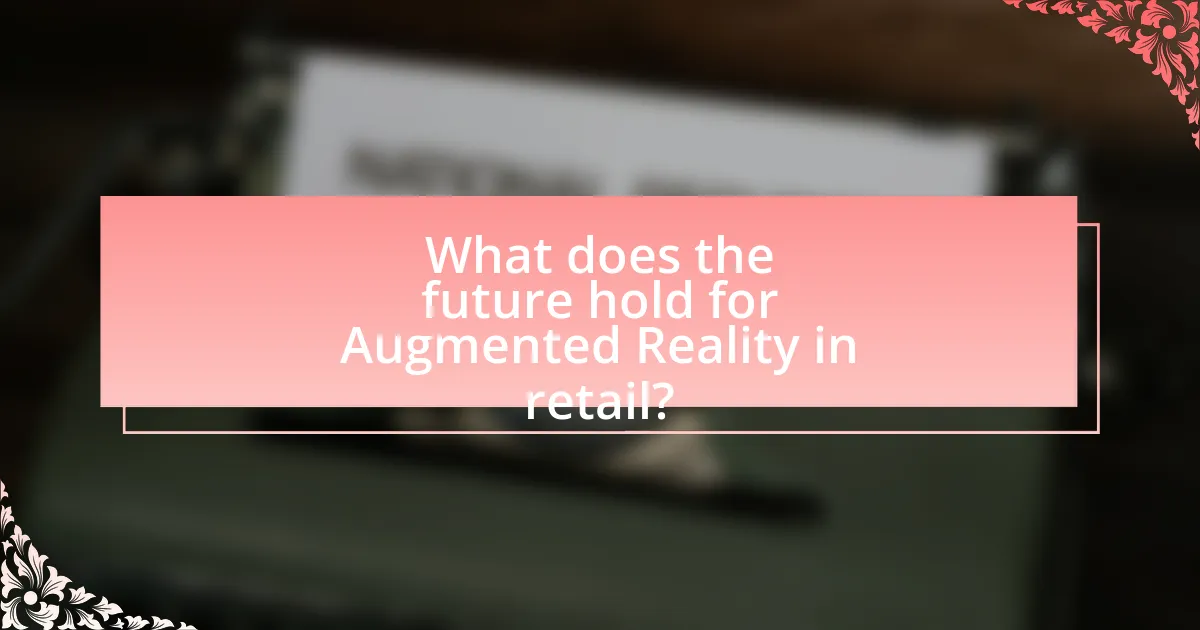Augmented Reality (AR) in retail is a transformative technology that enhances the shopping experience by overlaying digital information onto the physical environment, allowing customers to visualize products in their own spaces. This article explores how AR improves customer engagement, reduces return rates, and increases sales conversion rates through interactive experiences. It examines the technologies involved, current trends, successful case studies, and the challenges retailers face in adopting AR solutions. Additionally, the article discusses the future of AR in retail, including the role of artificial intelligence and evolving consumer behavior, while providing strategies and best practices for effective implementation.

What is Augmented Reality in Retail?
Augmented Reality in retail is a technology that overlays digital information, such as images or animations, onto the real-world environment, enhancing the shopping experience. This technology allows customers to visualize products in their own space before making a purchase, leading to increased engagement and informed decision-making. For instance, a study by Deloitte found that 40% of consumers are willing to pay more for a product if they can experience it through augmented reality, demonstrating its effectiveness in driving sales and customer satisfaction.
How does Augmented Reality enhance the retail experience?
Augmented Reality (AR) enhances the retail experience by providing interactive and immersive shopping environments that allow customers to visualize products in real-time. For instance, AR applications enable consumers to see how furniture would look in their homes or how clothing fits without trying them on physically. According to a study by Deloitte, 40% of consumers expressed a preference for shopping experiences that incorporate AR, indicating its effectiveness in engaging customers and improving satisfaction. This technology not only increases customer engagement but also reduces return rates, as customers can make more informed purchasing decisions.
What technologies are involved in Augmented Reality for retail?
Augmented Reality (AR) for retail involves several key technologies, including computer vision, simultaneous localization and mapping (SLAM), depth tracking, and mobile devices. Computer vision enables the recognition of objects and environments, allowing AR applications to overlay digital content accurately onto the physical world. SLAM technology helps in mapping the environment in real-time, which is crucial for placing virtual objects in the correct spatial context. Depth tracking enhances the realism of AR experiences by providing information about the distance of objects from the camera, ensuring that virtual items interact naturally with the physical surroundings. Mobile devices, equipped with AR software and hardware capabilities, serve as the primary platforms for delivering these immersive experiences to consumers.
How do consumers interact with Augmented Reality in retail settings?
Consumers interact with Augmented Reality (AR) in retail settings primarily through mobile applications and in-store displays that enhance their shopping experience. These interactions allow consumers to visualize products in their own environment, try on virtual clothing or accessories, and access additional product information through their smartphones or AR devices. For instance, a study by Deloitte found that 40% of consumers are willing to pay more for a product if they can experience it through AR, indicating a strong preference for immersive shopping experiences. This engagement not only increases consumer satisfaction but also drives higher conversion rates, as AR tools can reduce uncertainty in purchasing decisions.
What are the key benefits of using Augmented Reality in retail?
The key benefits of using Augmented Reality in retail include enhanced customer engagement, improved product visualization, and increased sales conversion rates. Augmented Reality allows customers to interact with products in a virtual environment, leading to a more immersive shopping experience. For instance, a study by Deloitte found that retailers using AR saw a 40% increase in customer engagement and a 30% increase in conversion rates. Additionally, AR enables customers to visualize how products will look in their own space, reducing return rates and increasing customer satisfaction.
How does Augmented Reality improve customer engagement?
Augmented Reality (AR) improves customer engagement by providing immersive and interactive experiences that enhance product visualization. For instance, AR allows customers to visualize how furniture would look in their homes before making a purchase, significantly increasing their confidence in buying decisions. Research by Deloitte indicates that 88% of consumers prefer retailers that offer AR experiences, demonstrating a clear link between AR implementation and heightened customer interest and satisfaction. This technology not only captivates customers but also fosters a deeper emotional connection with brands, ultimately driving sales and loyalty.
What impact does Augmented Reality have on sales and conversion rates?
Augmented Reality (AR) significantly enhances sales and conversion rates by providing immersive shopping experiences that engage customers more effectively. Research indicates that retailers utilizing AR can see conversion rates increase by up to 40%, as customers are more likely to make purchases when they can visualize products in their own environment. For instance, a study by Deloitte found that 88% of consumers prefer retailers that offer AR experiences, leading to higher customer satisfaction and loyalty. This engagement not only boosts immediate sales but also fosters long-term relationships, ultimately driving revenue growth.

What are the current trends in Augmented Reality for retail?
Current trends in Augmented Reality (AR) for retail include the integration of virtual try-ons, interactive product displays, and enhanced customer engagement through immersive experiences. Retailers are increasingly adopting AR technology to allow customers to visualize products in their own environment before making a purchase, with companies like IKEA using AR apps to enable users to see how furniture fits in their homes. Additionally, brands such as Sephora and L’Oreal have implemented virtual try-on features that let customers test makeup products digitally, significantly improving the shopping experience. According to a report by Statista, the AR market in retail is projected to reach $1.6 billion by 2025, highlighting the growing importance of AR in enhancing consumer interaction and driving sales.
How are retailers currently implementing Augmented Reality solutions?
Retailers are currently implementing Augmented Reality (AR) solutions by integrating AR technology into their shopping experiences to enhance customer engagement and streamline purchasing processes. For instance, companies like IKEA utilize AR apps that allow customers to visualize furniture in their own homes before making a purchase, significantly improving decision-making and reducing return rates. Additionally, brands such as Sephora offer virtual try-on features through AR, enabling customers to test makeup products digitally, which has been shown to increase conversion rates by up to 30%. These implementations demonstrate how retailers leverage AR to create immersive experiences that drive sales and customer satisfaction.
What are some successful case studies of Augmented Reality in retail?
IKEA’s augmented reality app, IKEA Place, allows customers to visualize furniture in their homes before purchasing, leading to a 20% increase in sales. Sephora’s Virtual Artist app enables users to try on makeup virtually, resulting in a 94% increase in conversion rates. Lowe’s uses AR to help customers visualize home improvement projects, which has improved customer engagement and satisfaction. These case studies demonstrate the effectiveness of augmented reality in enhancing the retail experience and driving sales.
How do different retail sectors utilize Augmented Reality differently?
Different retail sectors utilize Augmented Reality (AR) in distinct ways to enhance customer experience and drive sales. In the fashion sector, AR allows customers to virtually try on clothing and accessories through apps, improving fit and style decisions; for instance, brands like Zara and ASOS have implemented AR fitting rooms. In the furniture sector, companies like IKEA use AR to enable customers to visualize how furniture would look in their homes, facilitating informed purchasing decisions. The beauty industry employs AR for virtual makeup try-ons, with brands like L’Oréal offering apps that allow users to see how products will look on their skin. Each sector leverages AR technology to address specific consumer needs, enhancing engagement and satisfaction.
What challenges do retailers face when adopting Augmented Reality?
Retailers face several challenges when adopting Augmented Reality (AR), including high implementation costs, technical limitations, and consumer acceptance issues. High implementation costs can deter retailers, as developing AR applications and integrating them into existing systems often requires significant financial investment. Technical limitations, such as the need for advanced hardware and software, can also pose obstacles, as not all retailers have the necessary infrastructure. Additionally, consumer acceptance issues arise when customers are unfamiliar with AR technology or skeptical about its benefits, which can hinder widespread adoption. According to a study by Deloitte, 70% of consumers expressed a preference for traditional shopping experiences over AR-enhanced ones, highlighting the need for retailers to effectively educate and engage their customers about the advantages of AR.
What are the technological barriers to implementing Augmented Reality?
The technological barriers to implementing Augmented Reality (AR) include limited hardware capabilities, insufficient software development tools, and challenges in integrating AR with existing systems. Limited hardware capabilities, such as low processing power and inadequate display technology, hinder the performance and user experience of AR applications. Insufficient software development tools restrict developers’ ability to create effective AR experiences, as many platforms lack robust frameworks and libraries. Additionally, challenges in integrating AR with existing retail systems, such as inventory management and customer relationship management, complicate the deployment of AR solutions. These barriers collectively impede the widespread adoption of AR in the retail sector.
How do consumer perceptions affect the adoption of Augmented Reality?
Consumer perceptions significantly influence the adoption of Augmented Reality (AR) by shaping attitudes towards its usefulness and ease of use. Positive perceptions, such as viewing AR as innovative and beneficial for enhancing shopping experiences, lead to higher acceptance rates among consumers. For instance, a study by Poushneh and Vasquez-Parraga (2017) found that consumers who perceived AR as enhancing product visualization were more likely to adopt AR applications in retail settings. Conversely, negative perceptions, such as concerns about privacy or technological complexity, can hinder adoption. Therefore, addressing consumer perceptions through effective marketing and education is crucial for increasing AR adoption in retail environments.

What does the future hold for Augmented Reality in retail?
The future of Augmented Reality (AR) in retail is poised for significant growth, driven by advancements in technology and consumer demand for immersive shopping experiences. Retailers are increasingly adopting AR to enhance customer engagement, with studies indicating that 61% of consumers prefer retailers that offer AR experiences. This technology enables virtual try-ons, interactive product displays, and personalized shopping experiences, which can lead to higher conversion rates and customer satisfaction. As AR technology becomes more accessible and affordable, its integration into retail strategies is expected to expand, transforming how consumers interact with products and brands.
How will advancements in technology shape Augmented Reality in retail?
Advancements in technology will significantly enhance Augmented Reality (AR) in retail by improving user experience, increasing personalization, and streamlining operations. For instance, the integration of artificial intelligence and machine learning allows retailers to analyze consumer behavior and preferences, enabling tailored AR experiences that resonate with individual shoppers. According to a report by Deloitte, 88% of retailers believe that AR can enhance customer engagement, demonstrating its potential impact on sales and brand loyalty. Furthermore, advancements in mobile technology and 5G connectivity will facilitate faster and more immersive AR applications, allowing customers to visualize products in real-time and in their own environments. This technological evolution is expected to transform the retail landscape by making shopping more interactive and efficient.
What role will artificial intelligence play in the future of Augmented Reality?
Artificial intelligence will play a crucial role in enhancing the functionality and user experience of augmented reality in retail. AI will enable personalized shopping experiences by analyzing consumer data and preferences, allowing AR applications to provide tailored product recommendations and virtual try-ons. For instance, a study by Accenture found that 91% of consumers are more likely to shop with brands that provide relevant offers and recommendations, highlighting the importance of AI in delivering personalized content. Additionally, AI-driven image recognition will improve the accuracy of AR overlays, ensuring that virtual products align seamlessly with the physical environment, thereby increasing consumer engagement and satisfaction.
How might consumer behavior evolve with the growth of Augmented Reality?
Consumer behavior is likely to evolve significantly with the growth of Augmented Reality (AR) by enhancing engagement and personalization in the shopping experience. As AR technology becomes more integrated into retail, consumers will increasingly expect immersive experiences that allow them to visualize products in their own environments before making a purchase. For instance, a study by Deloitte found that 40% of consumers are willing to pay more for a product if they can experience it through AR, indicating a shift towards valuing experiential shopping. Additionally, AR can facilitate informed decision-making by providing detailed product information and virtual try-ons, which can reduce return rates and increase customer satisfaction. This evolution in consumer behavior reflects a broader trend towards digital integration in retail, where convenience and personalization are paramount.
What strategies can retailers adopt to effectively integrate Augmented Reality?
Retailers can effectively integrate Augmented Reality (AR) by adopting strategies such as enhancing customer engagement through interactive experiences, utilizing AR for virtual try-ons, and implementing location-based AR features. Enhancing customer engagement can be achieved by creating immersive shopping experiences that allow customers to visualize products in their own environment, which has been shown to increase purchase intent by up to 40% according to a study by Deloitte. Utilizing AR for virtual try-ons enables customers to see how products, such as clothing or makeup, would look on them without physical trials, leading to a reduction in return rates by approximately 25%, as reported by the National Retail Federation. Implementing location-based AR features can guide customers to products in-store, improving navigation and overall shopping efficiency, which can enhance customer satisfaction and loyalty.
What best practices should retailers follow when implementing Augmented Reality solutions?
Retailers should prioritize user experience, ensuring that Augmented Reality (AR) solutions are intuitive and enhance customer engagement. A seamless integration of AR into the shopping experience can significantly increase customer satisfaction and sales; for instance, a study by Deloitte found that 88% of consumers prefer retailers that offer AR experiences. Additionally, retailers should invest in high-quality content and technology to provide realistic and interactive AR experiences, as this can lead to a 40% increase in conversion rates, according to a report by Shopify. Furthermore, retailers must continuously gather user feedback to refine their AR offerings, ensuring they meet evolving customer expectations and preferences.
How can retailers measure the success of their Augmented Reality initiatives?
Retailers can measure the success of their Augmented Reality initiatives through key performance indicators (KPIs) such as user engagement, conversion rates, and customer feedback. User engagement can be assessed by tracking metrics like the duration of AR interactions and the frequency of use, which indicate how effectively the AR experience captures consumer interest. Conversion rates provide insight into how many users make purchases after engaging with AR features, with studies showing that AR can increase conversion rates by up to 40%. Customer feedback, gathered through surveys and reviews, offers qualitative data on user satisfaction and areas for improvement, reinforcing the effectiveness of the AR initiatives.


